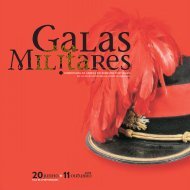Versão digital - Museu de Angra do Heroísmo
Versão digital - Museu de Angra do Heroísmo
Versão digital - Museu de Angra do Heroísmo
Create successful ePaper yourself
Turn your PDF publications into a flip-book with our unique Google optimized e-Paper software.
CLIPPER FLYING CLOUD<br />
O “Flying Cloud”, <strong>de</strong> 1851, foi o mais famoso <strong>do</strong>s clippers “radicais” construí<strong>do</strong>s por<br />
Donald McKay em Boston, encomenda<strong>do</strong> por Enoch Train, que pagou US 50$000 pela<br />
sua construção.<br />
Seis semanas <strong>de</strong>pois <strong>de</strong> lança<strong>do</strong> á água, o navio velejou <strong>de</strong> Nova Iorque a S. Francisco via<br />
Cabo Horn em 89 dias e 21 horas, sob o coman<strong>do</strong> <strong>do</strong> Cap. Josiah Perkins Cressy. A 31 <strong>de</strong><br />
Julho, durante a viagem, o navio fez 374 milhas náuticas em 3 dias. Em 1843, bateu o<br />
seu próprio record por 13 horas, uma marca que permaneceu imbatível até 1989,<br />
quan<strong>do</strong> um veleiro construí<strong>do</strong> com essa finalida<strong>de</strong>, “Thursday Child”, completou a<br />
passagem em 80 dias e 20 horas. O record foi bati<strong>do</strong> <strong>de</strong> novo em 2008, pelo iate francês<br />
<strong>de</strong> regata “Gitana 13”, com um tempo <strong>de</strong> 43 dias e 38 minutos.<br />
Nos primeiros tempos da Corrida ao Ouro da Califórnia, era preciso, em média, mais <strong>de</strong><br />
200 dias para um navio viajar <strong>de</strong> Nova Iorque a S. Francisco, uma passagem <strong>de</strong> mais <strong>de</strong><br />
16.000 milhas. O “Flying Cloud”, mais <strong>do</strong> que cortar o tempo a meio (apenas 89 dias),<br />
estabeleceu um record <strong>de</strong> referência mundial que o próprio navio haveria <strong>de</strong> bater 3 anos<br />
<strong>de</strong>pois, crian<strong>do</strong> um novo record que perdurou por 136 anos.<br />
O feito <strong>do</strong> “Flying Cloud” foi memorável sob qualquer prisma. Mas foi ainda mais<br />
invulgar pelo facto <strong>do</strong> seu navega<strong>do</strong>r ser uma mulher, Eleanor Cressy, esposa <strong>do</strong> capitão<br />
<strong>do</strong> navio, que estudava as correntes oceânicas, fenómenos meteorológicos e astronomia<br />
<strong>de</strong>s<strong>de</strong> a infância. Com o mari<strong>do</strong>, ela acumulou milhares <strong>de</strong> milhas nos oceanos,<br />
navegan<strong>do</strong> à volta <strong>do</strong> mun<strong>do</strong>, transportan<strong>do</strong> passageiros e bens. Na esteira <strong>do</strong><br />
estabelecimento <strong>do</strong> seu record <strong>de</strong> Nova Iorque à Califórnia, Eleanor e Josiah tornaram-se<br />
instantaneamente em celebrida<strong>de</strong>s. Mas a sua fama foi curta e a sua história rapidamente<br />
esquecida. Josiah faleceu em 1871 e Eleanor viveu longe <strong>do</strong> mar até à sua morte em 1900.<br />
Em 1862, o “Flying Cloud” foi vendi<strong>do</strong> para navegar sob ban<strong>de</strong>ira inglesa, sem mudança<br />
<strong>de</strong> nome e em pouco tempo navegava entre o Reino Uni<strong>do</strong> e a Austrália e Nova<br />
Zelândia. Os seus últimos tempos foram passa<strong>do</strong>s no transporte <strong>de</strong> ma<strong>de</strong>iras entre a Grã-<br />
Bretanha e St. John, no Canadá. No dia 19 <strong>de</strong> Junho <strong>de</strong> 1874, o “Flying Cloud” encalhou<br />
na barra <strong>de</strong> Beacon Island, na Terra Nova, ficou irrecuperável e foi vendi<strong>do</strong>. Um ano mais<br />
tar<strong>de</strong> foi queima<strong>do</strong> para se aproveitar a sucata <strong>de</strong> metal e o poleame <strong>de</strong> cobre.<br />
página | 15<br />
CLIPPER “FLYING CLOUD”<br />
The Flying Cloud, of 1851, was the most famous of the extreme clippers<br />
built by Donald McKay in East Boston, Massachusetts, inten<strong>de</strong>d for Enoch<br />
Train of Boston, who paid $50,000 for her construction.<br />
Within six weeks after launched, she sailed from New York and ma<strong>de</strong> San<br />
Francisco round Cape Horn in 89 days, 21 hours un<strong>de</strong>r the command of<br />
Captain Josiah Perkins Cressy. On July 31, during the trip, she ma<strong>de</strong> 374<br />
miles in 3 days. In 1853 she beat her own record by 13 hours, a record that<br />
stood until 1989 when the breakthrough-<strong>de</strong>signed sailboat Thursday’s Child<br />
completed the passage in 80 days, 20 hours. The record was once again<br />
broken in 2008 by the French racing yacht Gitana 13 with a time of 43 days<br />
and 38 minutes.<br />
In the early days of the California Gold Rush, it took more than 200 days for<br />
a ship to travel from New York to San Francisco, a voyage of more than<br />
16,000 miles. The Flying Cloud’s better-than-halving that time (only 89 days)<br />
was a headline-grabbing world record that the ship itself beat three years<br />
later, setting a record that lasted for 136 years.<br />
The Flying Cloud’s achievement was remarkable un<strong>de</strong>r any terms. But, it<br />
was all the more unusual because its navigator was a woman, Eleanor<br />
Cressy, married to the ship captain Josiah Perkins Cressy, who had been<br />
studying oceanic currents, weather phenomena, and astronomy since her<br />
girlhood. With her husband, she logged many thousands of miles in the<br />
ocean, traveling around the world carrying passengers and goods. In the<br />
wake of their record-setting transit from New York to California, Eleanor and<br />
Josiah became instant celebrities. But their fame was short-lived and their<br />
story quickly forgotten. Josiah died in 1871 and Eleanor lived far from the<br />
sea until her <strong>de</strong>ath in 1900.<br />
In 1862, Flying Cloud was sold to go un<strong>de</strong>r British colors without change of<br />
name, and was soon traveling between the mother country and Australia<br />
and New Zealand. Her latter years were spent in the timber tra<strong>de</strong> between<br />
Britain and St. Johns, Canada. On June 19, 1874 the Flying Cloud went<br />
ashore on the Beacon Island bar, St. John’s, Newfoundland, and was<br />
con<strong>de</strong>mned and sold. The following June she was burned for the scrap<br />
metal value of her copper and metal fastenings.<br />
CLIPPER FLYING CLOUD<br />
MAH R.1993.787



